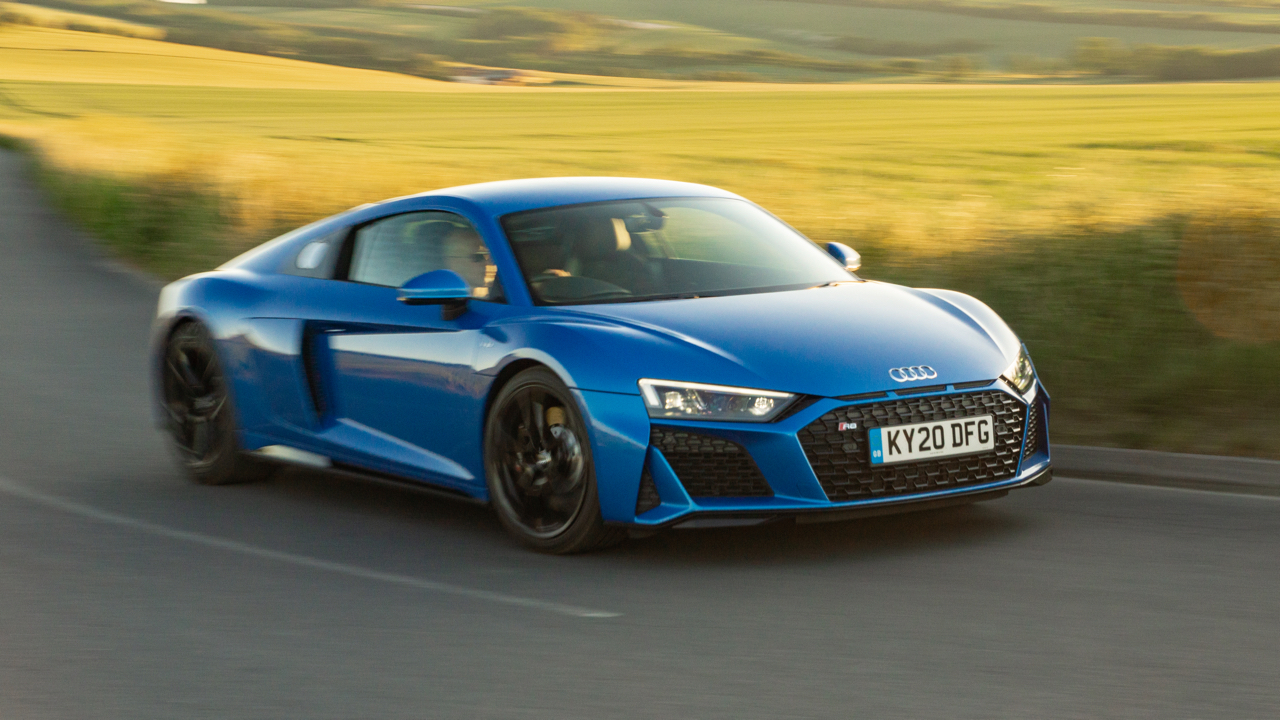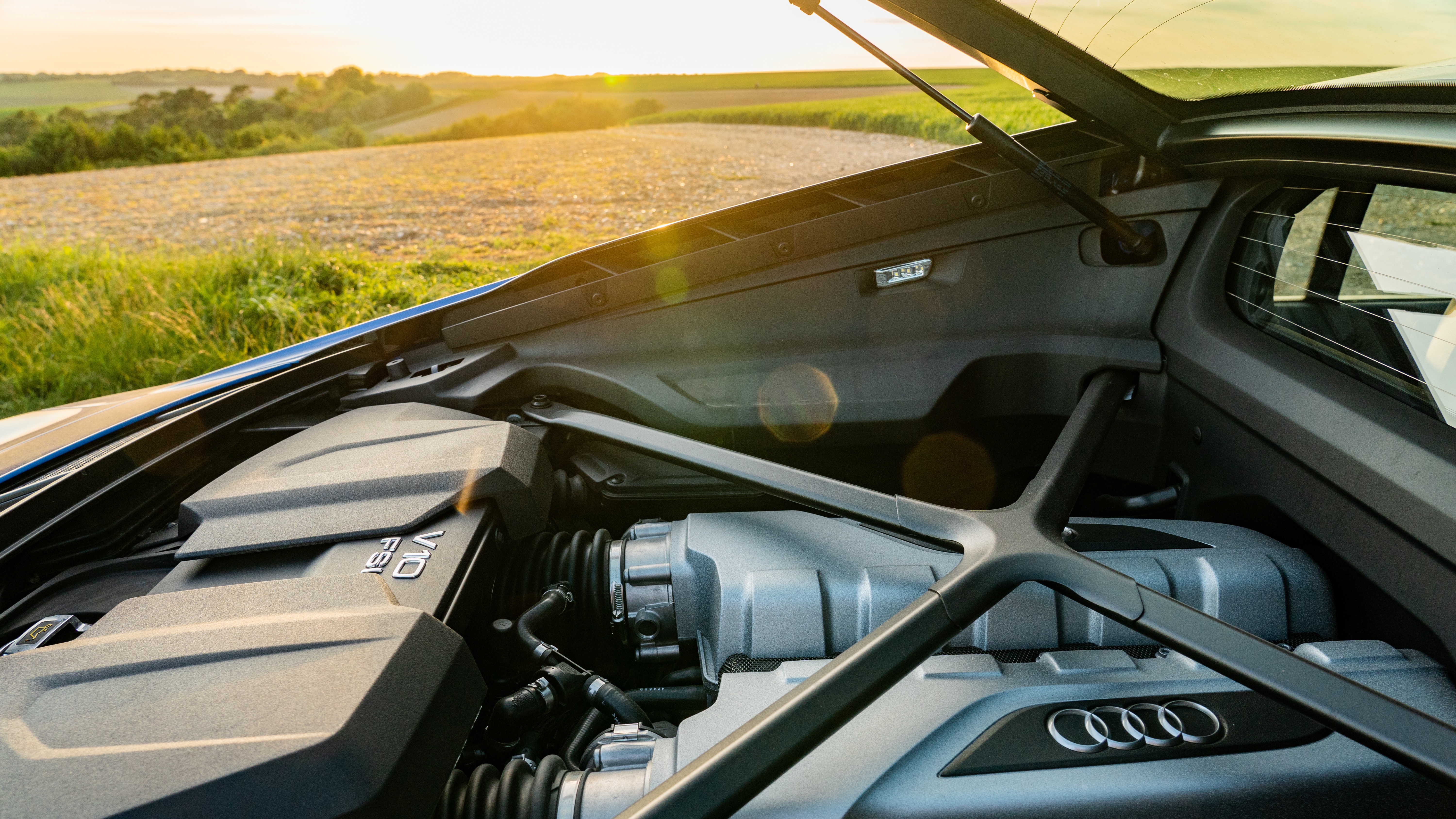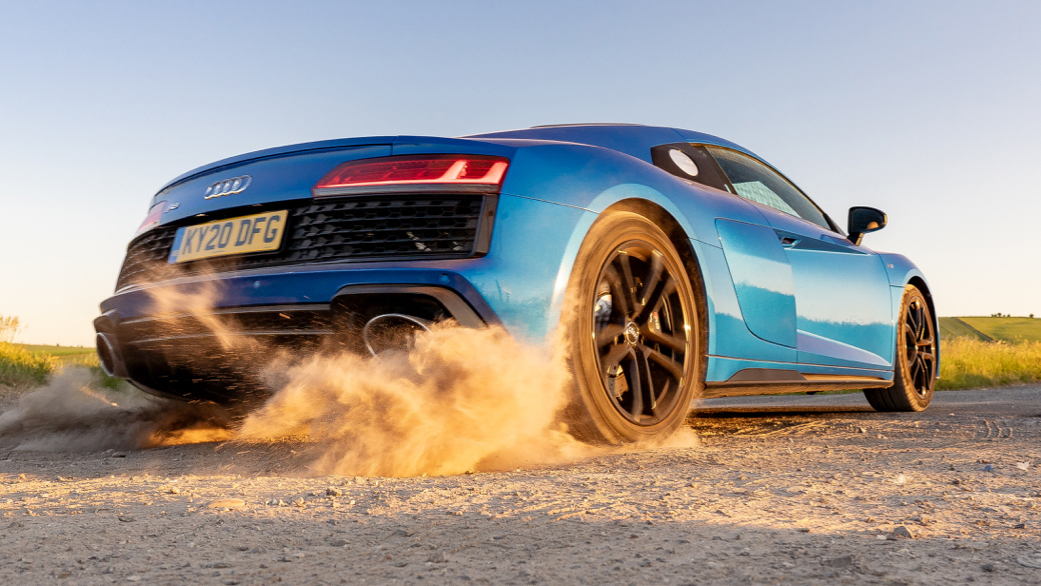
Audi R8 RWD review: entry-level, rear-drive supercar's first UK test
Hang about, didn’t this used to be called the R8 RWS?
It did. When it was launched in 2018 the Rear Wheel Series was a limited production run of 999 cars. Then last year Audi facelifted the R8 range, giving it a sharper nose and some minor dynamic enhancements. Those actually had quite a lot in common with the work already done on the RWS – steering geometry, thicker front anti-roll bar, stiffer dampers. But I digress. The RWS is back, renamed the RWD and now a permanent part of the range.
What’s changed since 2018 then?
Very little. It’s obviously got the new, sharper R8 nose and that sits very well on it, but aside from that, the RWD is basically the same car as the RWS. Not just in terms of its performance and positioning in the range, but its attitude on the road.
It’s the entry-level R8, so has the naturally aspirated V10 in its least potent 533bhp guise, driving the rear wheels through a seven speed twin clutch gearbox. The diff is mechanical, the dampers aren’t adaptive or adjustable. It’s the simplest R8.
And the most basic…
Correct. You can’t have it with the magnetic ride dampers, even if you want them, and the sideblades can only be body colour (probably the easiest and most reliable way to spot a RWD, as there’s no external badging to inform). It’s £115,890, undercutting the 562bhp quattro version by nearly £15,000, and the 602bhp Performance model by almost double that. For £124,580 you can also have it as a Spyder. At the moment Audi finance will lease you this R8 for £12,000 down and £1,500 a month over 48 months. Watch the lump sum at the end though…
But here’s what I find puzzling about the R8 RWD: it does the same job in the same manner as any other R8.
How do you mean?
The way I see it, the RWD was a chance to give the R8 range more bandwidth. We’ve got the quattro, this one is 50kg lighter and simpler, so could have been used as a showcase to demonstrate Audi Sport is serious about delivering a driver’s car with real tactility and feedback. An alternative to a Porsche 911 GT3 in fact. Which is the exact test we did with the RWS a couple of years back. Unfortunately nothing has changed since. I didn’t really expect it to. Audi is a pragmatic company and I don’t doubt they know their audience better than I do. But I still think this means they’re selling themselves short and failing to prove that, given the perfect ingredients, Audi Sport can create a belting driver’s car.
Top Gear
Newsletter
Thank you for subscribing to our newsletter. Look out for your regular round-up of news, reviews and offers in your inbox.
Get all the latest news, reviews and exclusives, direct to your inbox.
Is the R8 RWS disappointing?
It depends on your expectations, doesn’t it? If you agree with what I’ve just said, then yes. However, if you think the idea of a naturally aspirated, rear-drive, mid-engined, two seat supercar costing Porsche 911 money and undercutting the likes of the Aston Martin Vantage is a winner whichever way, then no.
Because it does drive very well indeed. The V10 is a marvel, simple as that. From 3,000rpm onwards it delivers a smooth shove of increasing urgency. It’s a lovely feeling to see the rev needle rising rapidly past 5,000rpm, hear the smoothly ferocious engine sing with such focus and intent and realise you still have another 3,500rpm to go before the cut-out. The scenery spools through the wide windscreen, the V10 sings behind you, the cabin quality and layout is peerless, it feels good to be in an Audi R8 RWD on a good road on a summer’s day. It feels special. And no need for 4WD – unless you live somewhere with hairpins and cold temperatures.
But nor has Audi maximised the benefits associated with having front wheels that do nothing but steer. The steering is more sensitive just off centre than pre-facelift 4WD cars, but it’s also slightly numb. You get response from it, but little feel or texture. It doesn’t tingle or persuade you that it wants to attack a road. And don’t get me started on the traction control. It’s like Audi decided it was OK being rear-wheel drive, as long as there was absolutely no possibility of it doing anything exciting. It cuts in all the time, so you have to slacken it off, and then it’s fine. But seriously Audi, the R8 doesn’t have bicycle tyres on the back, the traction control doesn’t have to constantly intrude.
With the traction control neutered, you get good feel from the back axle on the way out of corners. It’s not able to get power down as effectively as the quattro versions obviously, but you feel like you’re closer to the limits here, can’t just give the damn thing all the throttle after the apex and have it hook up and go. A bit of finesse is required.
The passive suspension strikes a good balance – the damping has a cushioned edge that manages to take the sting out of daily driving, but maintains composure when going hard. Barely any roll, great traction, nicely set-up. Just needs better steering. And 150kg taken out. And more precise suspension…
But it’s not that car. Bet it’s easy to drive though.
Of course it is. The delights of an Audi cockpit. So instead I’m going to point out a couple of foibles. The seat is too high. The pedals are too far up the footwell. The door needs an extra opening point midway between ‘skinny person only’ access and ‘whoops, I thought I was miles away, but my door has just swung into the Ford Mondeo six feet away’. Nothing has been done to enhance the front boot volume despite the absence of front driveshafts. The 112-litre area behind the seats is bigger.
On the flip side, phone integration is seamless, the optional B&O stereo has the power to at least rival the engine without losing clarity and the standard Alcantara seats have decent support and comfort. You’d happily while away hours in here, if you weren’t always hopping in and out to refuel. The V10 is thirsty. You might, possibly, get over 20mpg on a long trip. Barrel around a bit and that’ll soon be down to 16mpg. The official claims are 22.2mpg and 293g/km. The numbers you’ll be more interested in are 3.7secs and 201mph.
How about the brakes and gearbox?
No carbon ceramics for the RWD, and the standard stoppers have too much bite at the top of the travel, and not enough power when given everything. For B-roads they’re reasonable but, like the steering, lack the sensitivity you want. The seven speed twin clutch is prompt and impressive – instant shifts and the calibration in normal and Sport modes is about bang on where most people would want it. I like to shift gears myself, and the RWD does that obediently, but the paddles are little and flimsy and plastic. Poor. The broad, sweeping power band and relatively closely spaced middle ratios mean the R8 sprints hard before getting leggier in sixth and seventh, where 70mph requires 2,000rpm.
Just a thought on modes: the button on the steering wheel cycles through Comfort, Dynamic and so on, altering maps for the engine/gearbox, steering and noise. It does so perfectly well, although the exhaust flap is purely for around town poncing. You get a throatier sound at tickover in Dynamic, but once up and running it doesn’t matter – it sounds bloody terrific from inside whatever you’re doing.
Which R8 would you have then?
I’m the wrong person to ask, because I’m slightly disappointed Audi hasn’t used the RWD to broaden the R8 offering, to turn it into something more exotic that might one day be collectable. However, it’s the R8 that would make sense to most people. You probably don’t need 4WD, and even though the numbers say it’s slower and 70bhp down on the Performance, it feels every bit as rapid. Maybe not as well equipped, but better value.
But when has that ever mattered to a supercar audience? Most buyers of these cars are doing so for status, buying the cheapest isn’t really an option. But being mid-engined and naturally aspirated, it does have an inherent exoticism these days that means it stands up well against the Porsche 911, Aston Martin Vantage and AMG GT. There’s nothing else that blends daily usability and a sense of occasion as happily as the R8, and this one does it most affordably. But is now really the time to be ploughing money into a supercar lease? That’s probably the first question you need to answer.
Featured

Trending this week
- Car Review
Porsche 911 GT3 (992.2)






